The Training Book
The training book is the output of O2 – Industrial design and design thinking book for intensive summer training. The book presents a collection of 23 learning activities aiming to activate the Open Education Resources (OERs) developed in O1 – Development of virtual training program.
Whereas the OERs have been developed for the student to read, listen and learn about a specific topic in relation to textile production and product design, the learning activities have been developed for the tutor as a means to activate the OERs in the classroom.
Background
The Open Educational Resources and the learning activities have been developed using an active and blended learning strategy to facilitate a flipped classroom setup (Bergmann & Sams, 2015). In the flipped classroom, students are expected to complete readings or targeted input from other information media at home and to engage with activating and often practice-based exercises during class time.
The pedagogic principles of the flipped classroom model can be described using Bloom’s Taxonomy of learning (Anderson et al., 2014). In the traditional model, students are to remember and understand new material in class, e.g. through lectures and readings and then to apply, analyze, evaluate and create themselves based on this material but outside class. In the flipped classroom model, students are to remember and understand new material before attending class, while classroom activities aim to help students apply, analyze, evaluate and create based on the prepared for material.
The argument behind this model is that the flipped class helps engaging students with activities in class that in different ways challenge their understanding of the material they’re working with.
Download the Training Book
Learning activities
The project partners have developed a total of 23 learning activities. Every learning activity links to an OER that can be found on the project website. The learning activities are described with an objective and scope including an activity question and learning goals to describe the aim of the given activity as well as support material, equipment and possible outcomes and one or two concrete deliveries of sub-activities marked with A and B.
The learning activities can be used as they are in class, but can also be adapted and serve as inspiration in combination with other activities and in other contexts and for other tasks.

